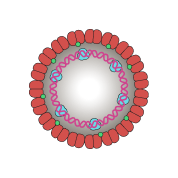Virus Explorer
Click and drag or use the buttons below to move the model.
Use the tab to focus one of the buttons above, and then space to start the rotation.
The proteins that make up the icosahedral capsid are shown.
Components on the virus are selectively represented in the 3D model for educational purposes.
A. DNA genome; B. Histone; C. Capsid proteins
This diagram shows how papillomaviruses, such as HPV, replicate, or make copies of themselves. First, capsid proteins on a papillomavirus’s surface bind to specific receptors on the host cell’s surface (A). This triggers a process known as endocytosis (B), which brings the virus into the cell in an enclosed structure (vesicle) called an endosome. Inside the endosome, the virus disassembles (C).
The virus travels inward through the ER-Golgi network, and the virus’s dsDNA genome enters the cell’s nucleus (D). With the help of the host cell’s machinery, the virus’s DNA is transcribed into mRNAs (F), which are translated into proteins by ribosomes in the cytosol (G), and copies of the virus’s DNA genome are made (E).
Viral genomes and proteins are assembled into new viruses inside the nucleus (I). The new viruses are released during the shedding of the host cell, which is when the cell naturally dies and breaks apart (J). Some papillomaviruses — including some that cause cancer in humans, such as HPV — will insert their DNA genome into the host cell’s genome (H). The inserted viral DNA is replicated by the cell, and descendants of the host cell will also contain the viral DNA. New viruses are not actively produced or are produced at very low levels.
Papillomavirus
- Papillomaviridae family
- ~55-nm naked icosahedral capsid
- Circular dsDNA genome of ~8,000 bp
- Infects many different organisms, including birds, fish, reptiles, amphibians, and cattle, humans, and other mammals
- Vaccine available that protects against several sexually transmitted papillomaviruses in humans
Papillomaviruses are a large family of viruses with over 100 recognized species as of 2020.
Many papillomaviruses infect humans and can cause symptoms ranging from benign growths (called warts, or papillomas) on the skin, respiratory tract, or genitals, to several types of cancer. In general, papillomaviruses are not zoonotic, although there have been isolated reports of animal-to-human transmission.
Certain human papillomaviruses (HPV) can cause genital warts and cancer. The first vaccines against these viruses became available in 2006.



